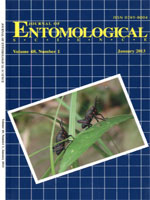There is much research and resource currently being invested in sweet sorghum, Sorghum bicolor L. Moench, for biofuel in southern Florida. The objective of this study was to determine the effect of planting date and density on insect pests of the crop in southern Florida. Emergent damage was primarily caused by fall armyworms, Spodoptera frugiperda (J.E. Smith), and to a lesser extent by the lesser cornstalk borer, Elasmopalpus lignosellus Zeller. Damage at heading was caused by different species of stink bugs (Heteroptera: Pentatomidae). Both emergent damage and numbers of stink bugs at heading varied significantly between planting dates. Correlation analysis showed that planting density had no to little effect on percentage damage by insects to emerging or heading sweet sorghum. Estimated ethanol yield was highest in the first crop of the early planting and decreased thereafter. No consistent effect of planting density or row configuration on yield was shown.
How to translate text using browser tools
1 January 2013
Effect of Planting Date and Density on Insect Pests of Sweet Sorghum Grown for Biofuel in Southern Florida
Ron Cherry,
Yueguang Wang,
Gregg Nuessly,
Rick Raid
ACCESS THE FULL ARTICLE
biofuel
fall armyworm
Pentatomidae
sweet sorghum





